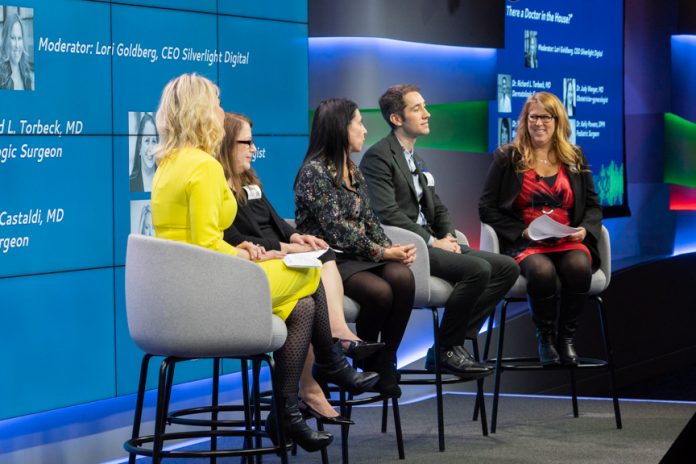Five years ago, Silverlight Digital (Silverlight) launched a vision with a simple webinar – their State of Digital report was delivered virtually with the goal of helping others in the industry understand current digital trends and emerging best practices. Today, their Pulse 2020 conference has grown to a standing-room-only crowd, filling the most coveted conference room at Google in New York City.
Through their partnership with Google as a Premier Partner, Silverlight delivered a highly actionable, informative and insightful agenda at their annual conference last Thursday.
The Pharma Marketing Network was honored to have a seat in the room and we are even more pleased to have the opportunity to share some of the key takeaways from this event with our followers.
The conference kicked off with warm welcomes from Silverlight CEO, Lori Goldberg & Google’s Group Lead, Matan Ariel. Understanding that the goal of these events is not just learning but also connection, attendees were encouraged to get to know each other by sharing details about the therapeutic areas they have expertise in and produce a visual representation of how our collective experiences create a cohesive view of the patient.

In the first session, “Is there a Doctor in the House?”, Lori moderated a panel discussion with four practicing physicians to gain insight into their personal interactions with technology, and the corresponding opportunities available to digital marketers to engage with their target practitioners.
The panel included:
- Dr. Richard Torbeck, MD, Dermatologic & Mohs Surgery
- Dr. Maria Castaldi, MD, Breast Surgery
- Dr. Judy Wenger, MD, Obstetrics & Gynecology
- Dr. Kelly Powers, DPM, Podiatric Surgery
Have you been wondering whether physicians carry their phones with them throughout their workday and if so, what they search for? We have been too.
The consensus from this panel was that for these physicians, their phones and mobile devices are just as much a part of their daily routines as they are for the rest of us, but they play particularly important roles for health care providers.
Two key themes quickly emerged: mobile’s role in patient education and communication and quick, “on-the-run” research on drug dosing, administration and usage guidelines.
One of the panelists shared that while she doesn’t carry her personal phone into the exam room, she always has her laptop on her desk, open and available to lookup drug interactions or provide patient education.
These physicians all commented on the value of using technology to search for instructional videos, patient testimonials and other useful content in addressing patient concerns and helping them become more comfortable with a diagnosis or recommended therapy or procedure.
One of the physicians shared that she carries three phones with her throughout the day to help her segment her various roles and responsibilities. Clearly, mobile is positioned to remain one of the most important channels for physician engagement.
The panel addressed the downside of mobile access and the proliferation of medical content online – the “Dr. Google” Phenomenon, where patients can now actively research their own symptoms and often begin to self-diagnose before they even talk to a physician. While there are definite benefits of the trend for consumers to become active partners in their care, the panelists agreed that consumer search activity can yield unfavorable side effects. Self-diagnosing can actually be dangerous, according to Dr. Powers, creating unnecessary anxiety and stress.
Dr. Torbeck shared that he will often tell patients “don’t Google this” and instead point them to specific online resources that he knows provide credible, responsible information.
Aside from patient education, how are physicians using digital media?
Dr. Wenger uses several medication Apps to gain information on drug dosing and administration guidelines. The old PDR book has been replaced by the PDR App and online portal that offer up-to-the-minute information about current guidelines. These interactive sites and tools offer value to physicians and marketers alike. On the flip side, she is wary of the many “throw away” print journals that she receives which include up to 50% ads and sparse credible content.
Dr. Castaldi affirmed that physicians need to get answers immediately. Search engines can lead you down the wrong path if you aren’t careful. She’s learned to do targeted searches and rely on results from specific sources that she trusts instead of what might be promoted on the top of the page.
Dr. Powers echoed this sentiment, confirming that she seeks out information from the Academies and Associations that she trusts the most. Sites like The Lancet and other similar journals are great routes to doctors since doctors trust their information and will often use these resources for patient information in addition to their own research.
Dr. Torbeck is an avid user of Google Scholar where he can use Boolean searches to get answers to questions that move beyond “is surgery the option…?” to more helpful answers like “is surgery the best option for this specific patient under these specific conditions?” In the past, he’d have to sift through hundreds of books or journals to read as much as he could and create his own answers to these questions. Today, access to this depth of online, cross-linked, content significantly speeds time to discovery.
The panel also dove into an open conversation about how they feel when their EHR and prescribing habits are used to drive marketing and sales efforts by industry. A word of caution for pharma reps: in general, MDs feel that it’s “creepy” when you walk in and tell them that you “see that they’ve been writing a lot of scripts for xyz drug.” Be informed but be smart about how or when you reference Rx data. (Or better yet, don’t reference it.)
The second presentation, “Human Truths: Health as Wellness,” invited Sofie Holt, Global Insights Analyst with Google to the stage to share insight into what consumers are looking for online. Google search data has been referred to as a truth elixir; people will tell Google things that they might not tell family members, doctors, focus groups, friends or researchers since searches can be anonymous and private. Analyzing search activity gives us a unique view into consumer concerns, interests, and needs.
What does the data show?
Consumers are questioning what their physicians tell them and are often doing additional research to triage their own symptoms and avoid going to the doctor. There are several dynamics that are pushing people to turn to alternative sources of information:
- Limited access to doctors – on average in the US, there are only 2.5 physicians per 1,000 people
- Declining trust in medical professionals – only 34% of Americans have great confidence in medical leaders (compared to 75% in 1966)
- Growing interest in preventable and lifestyle diseases
We are seeing a shift in focus from getting better to being better, from being informed to getting empowered, and from treating a condition to treating the self. These shifts are changing how consumers approach their health.
As a result, why questions in search are increasing more rapidly than how or what questions. Consumer searches are becoming more personal, more relevant, and more tailored to their own concerns and experiences.
One area of opportunity for marketers is in online testing/screening; consumers are clearly looking for quick assessments that can help them gain immediate knowledge. (Do I need to go to a doctor? Or not?)
One of the most actionable presentations of the day was delivered by Ruth Nightengale, Director, Search and Social Media at Silverlight – “Conquering Conquesting”
The data shows that it’s getting easier to earn your customer’s customer. Loyalty is hard won, so it makes sense that we are seeing growth in competitive conquesting tactics. But what should you do when you discover that your competitors are conquesting your search traffic by bidding on your branded keywords?
Before diving into strategies, Ruth provided tips for marketers to help them recognize when this is happening. Rather than spending time daily searching for your branded terms, look for these key indicators that can alert you to competitive activity:
- A sudden increase in the cost of your brand terms
- You may lose the top ranking for your brand’s name
- Dramatic changes in CTR that you can’t explain
- Content sites and OTC brands have entered the space
- Inability to spend at regular budget levels
Once you’ve identified an attack, how should you react?
It’s called a bidding war for a reason, but before you jump in make sure you are thinking strategically, not emotionally. Don’t start immediately bidding on your competitor’s brand names too. Don’t double down on keyword max bids to force a response. Be strategic.
Here are a few proven tactics that provide the foundation for a strategic response:
- Check your bidding strategy, especially on mobile. You may want to treat mobile bids differently since top of page positioning is more significant on the smaller screen
- Optimize to your site actions
- Evaluate risk/reward to any CPC increases
- Improve ad copy, if possible, to increase your click-through-rate naturally
Once the foundation is in place, it’s time to decide: fight of flight?
If you choose to Get in the Battle:
- Accept the risk
- Understand the cost
- Anticipate lower results
- Prepare alternative strategies
- Sharpen your SEO tools…HCPs will look beyond the paid ads for objective content
If you choose to Keep it Zen:
- Let your competitor spend their money at their own risk
- Ensure your CTR is hitting your goal
- Monitor. Monitor. Monitor.
- Keep your eyes on the prize – your KPIs! Stay focused on what you are looking to achieve and measure results and investments based on your own performance goals, not the competitive activity.
If you’d like full details about these and other sessions presented at the Pulse 2020 conference, or to learn more about Silverlight Digital’s services, please contact Lori Goldberg, CEO, Silverlight Digital at lgoldberg@silverlightdigital.com.



![6 Digital Tools at the Center of Healthcare Digitalization [INFOGRAPHIC]](http://ec2-54-175-84-28.compute-1.amazonaws.com/pharma-mkting.com/wp-content/uploads/2021/04/6DigitalTools_600px-218x150.jpg)




![6 Digital Tools at the Center of Healthcare Digitalization [INFOGRAPHIC]](http://ec2-54-175-84-28.compute-1.amazonaws.com/pharma-mkting.com/wp-content/uploads/2021/04/6DigitalTools_600px-100x70.jpg)




